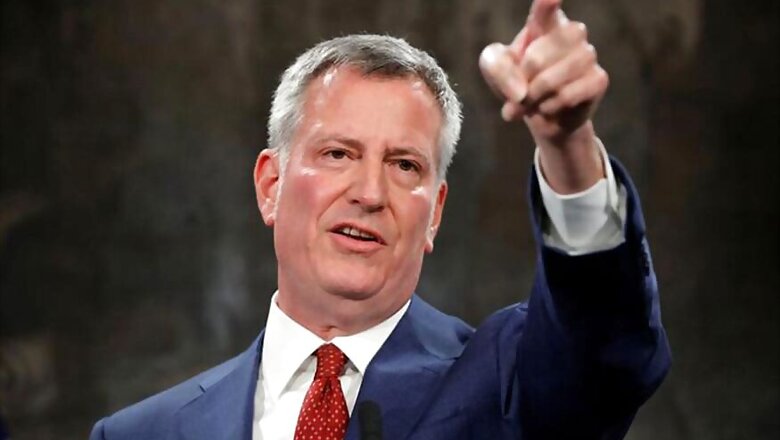
views
New York: The top black police official in New York City, Benjamin Tucker, went to Gracie Mansion on Sunday expecting the mayor to ask him to take the reins of the nation’s largest police force.
Only days before, the police commissioner, James P. O’Neill, had quietly and abruptly informed Mayor Bill de Blasio that he would be leaving to take a private-sector job.
Tucker, the second-highest-ranking official, had been passed over once before. But what he did not know as he arrived at Gracie Mansion, de Blasio’s official residence, was that the mayor planned to give the job to someone else, according to two city officials with knowledge of the meeting.
On Monday, the mayor announced that for the third time in a row, he had selected a white Irish-American police leader, Dermot F. Shea, 50, to run the increasingly diverse New York Police Department. Tucker was disappointed, one official said, and did not attend the announcement.
De Blasio has said he is committed to diversifying the city’s leadership and improving relations with the police in black and Hispanic neighborhoods, yet he has repeatedly opted for old-guard leaders for the Police Department.
Within hours, elected officials were openly questioning de Blasio’s choice, and the mayor found himself defending his decision in a television interview. He said the job was a “special calling” and dismissed the idea that “only one kind of person can foster change.”
“Everyone has to understand that this particular job, when it comes down to it, we’re asking one human being to do an extraordinary set of things and that’s a special calling,” he said in the interview on NY1 on Monday night.
De Blasio said he supported making the Police Department more racially diverse and promised that the leadership would be more and more diverse as well “in the coming years.”
For many elected officials and proponents of progressive criminal-justice policies, the promise rang hollow.
“This was a missed opportunity,” said Councilman Donovan J. Richards, a Queens Democrat who is the chairman of the City Council’s public safety committee, which oversees the police.
“We were looking for leadership that has that lived experience,” said Richards, who is black. “Even with all the good will that O’Neill and Shea have, they have not experienced stop and frisk. Their children have not experienced stop and frisk.”
Catalina Cruz, a state assemblywoman from Queens, was more blunt. “At a time when the relationship between police and communities of color couldn’t be worse — we chose yet another white guy?” she wrote on Twitter. “What gives?”
The Police Department did not make Tucker available for an interview.
De Blasio has been dogged since the start of his mayoralty with balancing the demands of his allies and constituents on the left, who want to revamp the Police Department and reduce incarceration, and the possibility of a revolt among rank-and-file officers angry about progressive criminal-justice policies.
He ran as a candidate critical of stop and frisk, a tough-on-crime tactic which critics said had been misused to unfairly target people of color. Then the death of Eric Garner, who died during an arrest on Staten Island in 2014, prompted angry protests against the police.
Months later, two officers were killed by a man who traveled to the city to attack the police. Officers turned their backs on the mayor at the funerals, as union leaders said the mayor’s rhetoric was partly to blame. The events rattled de Blasio.
The mayor still vowed change, but also supported budget increases and policing strategies that civil liberties advocates and public defenders said unfairly targeted black and Hispanic New Yorkers.
The rapid selection of Shea, the chief of detectives and a veteran of the Police Department who has been integral to its operations for years, was the third time that he had reached past high-ranking candidates of color for a white official.
“It’s a terrible message that’s being sent,” said Jumaane D. Williams, the city’s public advocate. “For an administration that says they want to do things differently, I don’t know that it’s really explainable.”
Robert E. Cornegy Jr., a City Council member from Brooklyn, agreed. He said Tucker was the official whom he would consult to discuss diversity in the Police Department or fair policing.
Internally, police officials have worried over changes to the criminal justice system, approved in Albany and set to take effect next year, that could affect some of the department’s street-level tactics. Shea and Tucker, as well as others in the top leadership, have been involved in the department’s preparations.
“This appointment in the mayor’s mind is probably the safest do-no-harm move,” said Councilman Rory Lancman, a Queens Democrat who supports changes to the criminal justice system. “Do you think the mayor wants to spend the next three months debating the future of the Police Department?”
When he took office in 2014, de Blasio considered two top-ranked officials from inside the Police Department — one Hispanic, the other black — to lead the department before settling on William J. Bratton, a former commissioner who pioneered an aggressive form of street policing focused on minor crimes known as “broken windows.”
When Bratton left in 2016, his No. 2 — the first deputy commissioner — was Tucker, who had spent 22 years in the Police Department and held public safety positions in city government and in the Clinton and Obama administrations before returning to New York.
But de Blasio passed over Tucker and chose O’Neill, a protégé of Bratton’s who had been in charge of implementing a neighborhood-based policing strategy. Tucker stayed on.
When the department’s top brass began discussing the impending leadership change late last week, Tucker appeared to be a leading candidate.
He went to Gracie Mansion on Sunday, according to a city official with knowledge of the discussions. Shea had been there the day before, a second official said. Both officials spoke on the condition of anonymity to share details of the private meetings.
Asked about the meetings, a spokeswoman for the mayor, Olivia Lapeyrolerie, said de Blasio “only made one offer for this job,” adding that Shea was the best choice because he was a “proven change agent.” She declined a request to interview de Blasio.
White officers make up a minority of the patrol ranks in the Police Department, but the top management is much less diverse: About 80% of those above the rank of captain are white, according to internal police personnel data from the start of 2018 obtained by the New York Civil Liberties Union.
Bratton, the former commissioner, said the speed of the decision suggested the mayor had never considered looking beyond the department’s current leadership.
“This is a mayor who believed that his credentials in the area of racial justice are very solid: a multiracial marriage, a diverse leadership in City Hall,” Bratton said in a telephone interview Tuesday. “I think he felt he had the political capital to make a decision where he could put another white guy in charge of the NYPD.”
But, he added, Tucker would have been a fine choice, as would Rodney Harrison, the chief of patrol, who is black, or John Miller, deputy commissioner for counterterrorism, who is white.
“If he put a black candidate, the Latinos would not have been happy,” Bratton said. “It is such a diverse city that no matter what you do, there will be criticism.”
J David Goodman and Ashley Southall c.2019 The New York Times Company




















Comments
0 comment